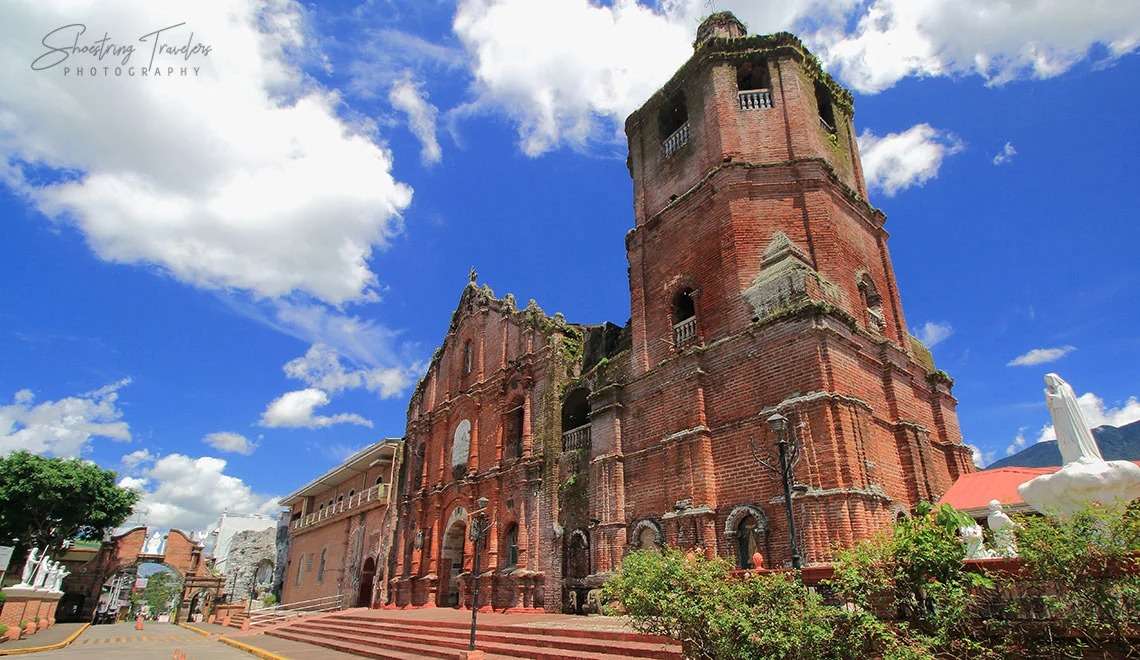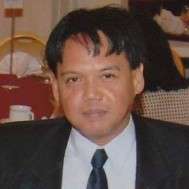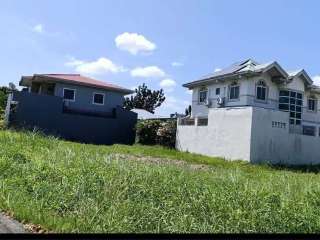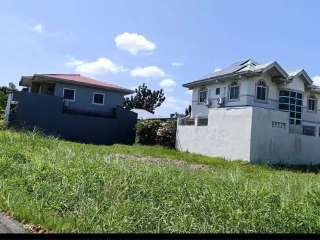About laguna
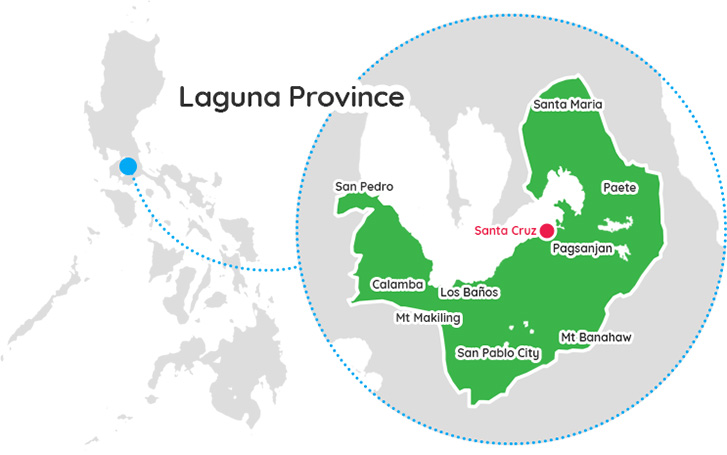
Laguna, officially the Province of Laguna, is a province in the Philippines located in the Calabarzon region in Luzon. Its name is derived from the Spanish word “lago,” meaning “lake.” Its capital is Santa Cruz while its largest city is the City of Calamba and the province is situated southeast of Metro Manila, south of the province of Rizal, west of Quezon, north of Batangas and east of Cavite. Laguna hugs the southern shores of Laguna de Bay, the largest lake in the country. It is the seventh richest province in the country.
Laguna is notable as the birthplace of José Rizal, the country's de facto national hero. It has numerous natural and cultural attractions such as Cavinti Falls aka Pagsanjan Falls, the University of the Philippines Los Baños and the University of the Philippines Open University in Los Baños, the hot spring resorts of Calamba on the slopes of Mount Makiling, Pila historic town plaza, Taytay Falls in Majayjay, the wood carvings and papier-mâché created by the people of Paete, the annual Sampaguita Festival in San Pedro, the turumba of Pakil, the tsinelas footwear from Liliw, the Pandan Festival of Luisiana, the Seven Lakes of San Pablo, and the Nagcarlan Underground Cemetery in Nagcarlan.
Laguna is part of Greater Manila Area along with Cavite, Rizal, and Bulacan.
History
Pre-Hispanic settlement in the area can be dated to prehistoric times, as evidenced in the names of towns such as Pila, Laguna, whose name can be traced to the straight mounds of dirt that form the boundaries of the rice paddy, or Pilapil. The written history of the province of Laguna, (Lagoon in Spanish) and that of the Southern Tagalog region, dates to 900 AD. The Laguna Copperplate Inscription is the oldest known written document found in the Philippines. It notes that its subject was released from a debt to the King of Tondo.
A prominent figure during the time of pre-Hispanic contact is Gat Pangil, a powerful native ruler in the area. The towns of Bay, Pangil and Pakil were reputed to have once been a part of his domain, although accounts vary about his identity.
The province of Laguna, which was formerly called La Laguna and La Provincia de la Laguna de Bay, was named after Laguna de Bay, the body of water that forms its northern boundary. Laguna de Bay, in turn, was named after the town of Bay, the first provincial capital. Captain Juan de Salcedo with a band of one hundred Spanish-Mexican soldiers conquered the province and its surrounding regions for Spain in 1571. The province of La Laguna comprised the modern province of Laguna, as well as parts of what are now known as Rizal and Quezon provinces.
In 1577, Spanish Franciscan missionaries arrived in Manila, and in 1578 they started evangelizing Laguna, Morong (now Rizal), Tayabas (now Quezon) and the Bicol Peninsula as part of the colonizing effort. Juan de Plasencia and Diego de Oropesa were the earliest Franciscans sent to these places. From 1580, the towns of Bay, Caliraya, Majayjay, Nagcarlan, Liliw, Pila, Santa Cruz, Lumban, Pangil and Siniloan were founded. During the time of Governor-General Gómez Pérez Dasmariñas, the province of La Laguna was divided into the following encomiendas:
Laguna was the site of multiple engagements during the Sangley Rebellion, made up of Chinese-Filipino mestizos. In 1603, Antonio de Morga relates how the Chinese rebels scattered to three divisions, one of which went to the mountains of San Pablo. Captain Don Luys de Velasco, aided by Spanish and Filipino forces, was successful in pursuing the rebels. Eventually the Chinese were able to kill Luys de Velasco and ten of his men, before securing themselves in San Pablo while waiting for reinforcement from the mainland. On October 20, 1603, Governor-General Pedro Bravo de Acuña then sent Captain Cristoval de Axqueta Menchaca to pursue and crush the rebellion and was successful after twenty days of fighting.
Around this time the hot springs of Los Baños and San Pablo were known to the Spanish, and a hospital was built in the area. By 1622, the hospital was notable enough to be mentioned by the Archbishop of Manila at the time, Miguel García Serrano in his letter to King Philip IV.
In 1639, a second rebellion involving the Chinese occurred, and the rebels fortified themselves in the highlands of Cavinti and Lumban before surrendering in Pagsanjan a year later.
In 1670, a delimitation of borders were made between Lucban, Majayjay and Cavite. The most populous town at that time, Bay, was capital of the province until 1688, when the seat of the provincial government was moved to Pagsanján. Pagsanján would be the provincial seat until 1858 when it was moved once again to Santa Cruz. In 1754, the province of Laguna and Tayabas were divided, with the Malinao River separating the towns of Majayjay and Lucban.
In 1678, Fray Hernando Cabrera founded San Pablo de los Montes (now San Pablo City) and built a wooden church and convent considered as the best and finest in the province.
Fighting extended to Laguna during the British occupation of Manila between the years of 1762–64. A detachment of British troops under Captain Thomas Backhouse entered the province in search of the silver cargo of the galleon Filipina while Francisco de San Juan led a band of volunteers that fought them in several engagements in and around the then provincial capital of Pagsanjan. Backhouse plundered the town and burned its newly reconstructed church but San Juan succeeded in escaping with the precious hoard to Pampanga where the treasure greatly bolstered the defense effort of Governor-General Simón de Anda y Salazar. For his actions, San Juan was made a brigade commander and alcalde mayor of Tayabas (now Quezon) province.
A major event in Laguna occurred in 1840, when religious intolerance led the people of Majayjay, Nagcarlan, Bay, and Biñan to join the revolt of Hermano Pule (Apolinario de la Cruz) of Lucban, Tayabas. This revolt was eventually crushed by Governor-General Marcelino de Oraá Lecumberri.
As part of political restructuring during the 19th century, the municipalities of Morong, Pililla, Tanay, Baras, Binangonan, Jalajala, Angono and Cardona were separated from Laguna and re-organized to the province Politico-Militar Distrito de Morong. In 1858, the provincial capital was once again moved from Pagsanjan to Santa Cruz, where it stands until today.
In 1861, José Rizal was born in Calamba to Francisco Mercado and Teodora Alonso. Rizal would become one of the leading members of the Propaganda Movement, who advocated political reforms for the colony. Rizal would go on to write two novels, Noli Me Tángere and El filibusterismo, which in part fueled additional anti-colonial sentiment, contributing to the eventual Philippine Revolution. In 1896, thousands of inhabitants, especially of Bay, Los Baños, Nagcarlan, Magdalena, Santa Cruz, and Pagsanjan had joined the revolutionary Katipunan. Rizal was executed on December 30, 1896, on charges of rebellion. Today, Rizal is recognized as a national hero of the Philippines.
Laguna was one of the eight provinces to rise in revolt against the Spanish misrule led by Generals Paciano Rizal in Calamba, Severino Taiño in Pagsanjan, Agueda Kahabagan in Calauan, and Miguel Malvar in Batangas. One of the early engagements of the revolution was the Battle of Sambat, in Pagsanjan. Katipuneros from Laguna, led by Severino Taiño, took the city of Pagsanjan and attempted to use it as a starting point towards the liberation of the province, but was quelled by forces led by Basilio Augustín.
The defeat in Sambat meant the end of large-scale organized revolt in Laguna, the Malungingnging chapter of the Katipunan failing to replicate the relative success of the revolution in Cavite. The revolutionaries resorted to hit-and-run and guerrilla tactics against the Spanish, lasting until the Pact of Biak-na-Bato on December 14 to 15, 1897. It was only after the execution of José Rizal that the revolution flared up again, culminating in the Battle of Calamba in May 1898, and the surrender of the last Spanish garrison in Laguna in Santa Cruz, on August 31 of the same year.
Laguna actively supported the First Philippine Republic proclaimed at Malolos on January 23, 1899. Its two delegates to the Malolos Congress were Don Higino Benítez and Don Graciano Cordero, both natives of Pagsanján.
Upon the outbreak of the Philippine–American War, Generals Juan Cailles and Paciano Rizal led the defense of Laguna during the war's early stages. The Battle of Mabitac was fought in defense of the town of Mabitac and was won by Filipino forces. However, forces led by Henry W. Lawton fought and won in Santa Cruz, Pagsanjan, and Paete, effectively securing the province for American forces. Resistance still occurred during this time. One of the province's folk hero during the continuing engagements was Teodoro Asedillo, who was considered a bandit by American forces.
By the end of the war, the entire country was occupied by American forces and was taken as a colony. The Taft Commission was established to govern the Philippines during the interim period, which appointed Juan Cailles as the provincial governor of Laguna. Act No. 83, or the Provincial Government Act, established a civilian government under American occupation. During this time, roads were built, schools were established, and in 1917, the Manila Railroad Company extended its line to Laguna as far as Pagsanjan.
In 1903, the town of Muntinlupa became part of La Laguna and was annexed to the town of Biñan, but was later returned to the province of Rizal in 1905.
uring the Japanese occupation of the Philippines (1942–1945), Laguna was a center of Filipino resistance despite the presence of Makapili collaborators.
Marking's Guerrillas raided the Cine Lumban in Laguna in June 1942 in an attempt to free the 115 American POWs. Only one American was rescued, Corporal George Lightman of the 3rd Pursuit Squadron, because the ranking American captain ordered his men to stay where they were. The Japanese executed 10 American prisoners in retribution.
Beginning in 1945, attacks by the Filipino soldiers of the 4th, 42nd, 43rd, 45th, 46th and 47th Infantry Division of the Philippine Commonwealth Army, 4th Constabulary Regiment of the Philippine Constabulary and the recognized guerrillas against Japanese forces in Laguna increased in anticipation of the Liberation of the Philippines by joint Filipino & American forces.
Members from laguna
Listings in laguna
More Provinces

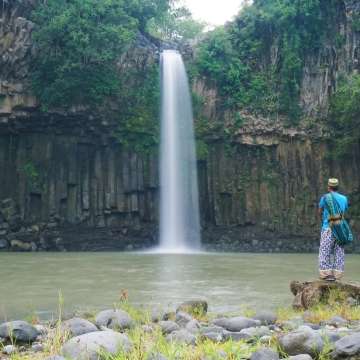
lanao del norte
Lanao del Norte, officially the Province of Lanao del Norte, is a province in the Philippines located in the Northern Mindanao region. Its capital is Tubod. The term Lanao is derived from a Maranao word “Ranao” meaning a body of water. “Maranao” means lake dweller. They are the natives of ...read more

